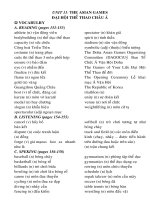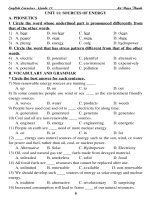unit 11 (E10cb)-writing
Bạn đang xem bản rút gọn của tài liệu. Xem và tải ngay bản đầy đủ của tài liệu tại đây (126.73 KB, 9 trang )
Letter
LESSON PLAN
Unit 11: National Park
Period 4: Writing
1. Class detail: grade 10 (basic level)
2. Time: 45 minutes.
3. Objectives:
After the lesson, students will be able to write letters of acceptance
and refusal.
4. Assumed knowledge: Students have already known how to write an
invitation letter.
5. Anticipated problems:
- Ss may not be familiar with expressions used in acceptance and
refusal letter, so teacher should teach them.
- There may be time left, so the teacher should prepare an extra
activity.
6. Teaching aids: textbook, handouts, posters, board
7. Procedure:
Time Teacher’s activities Students’
activities
4’
I. Warm-up:
Competition game – Network
- T prepares a handout with a network of the word
“letter”
- T divides class into 4 groups and gives each group a
handout.
- T asks Ss to complete the network with different
types of letter they know.
- T gives time for Ss to take part in the game
- The winner will be the group with the quickest and
many correct answers.
Suggested answers
- Make
groups
- Play the
game
6’
II. Pre-writing:
- T prepares 3 similar sets of statements which are
some common ways of inviting, accepting and
refusing.
- T divides the class into 3 groups.
- T gives each group a set of statements
- T gives instruction: Now, I’d like you to work in
your group and put the statements into the correct
column.
- T checks Ss’ understanding about instruction.
- Make
groups
- Listen to
T.
- Answer
T’s
questions
Questions for checking:
+ Do you work in pair or group?
Expected answer: work in group.
+ Asks a student: What group do you belong to?
+ What is your duty?
Expected answer: put the statements into the correct
column.
- Calls on representative of each group go to board
and write down their answers. (Each group in charge
of one column).
Suggested answers:
1. Inviting:
+ Would you like…
+ How about…
+ Do you feel like…
2. Accepting:
+ Yes, I’d like/ love to
+ Yes, that’s a great idea
+ Yes, I’d be delighted to
3. Refusing:
+ I’m afraid I can’t come because…
+ I’d love to, but…
+ I’m sorry I can’t because…
- T checks answers and gives feedback.
- T reads aloud the above expressions.
- T asks class to read after her.
- Go to the
board and
write the
answers.
- Listen to
T
- Read
aloud
4’
- T calls some Ss to read the expressions individually.
- T asks Ss to copy into their notebooks.
a. Activity 1 : Filling in the blank ( Task 1, page 117,
textbook)
Instruction: You are going to complete the letters in
task 1 by filling each blank with one of the ways to
accept or refuse an invitation provided in the table.
- T asks Ss to do the task in pairs and reminds
them that for each blank they can have more than
one answer.
- T checks students’ understanding about
instruction:
Questions for checking:
+ Do you work in pairs or work in groups?
Expected answer: work in pair
+ Do you complete the letters by filling each blank
with one of the ways to accept or refuse an
invitation provided in the table?
Expected answer: Yes
- T gives time for Ss to do the task.
- T calls on some Ss to go and write their answer
on the board.
- T calls for correction and gives T’s own
feedback
Suggested answers:
1. That’s a great idea! / I’d like to/ I’d love to.
2. I’m afraid I can’t come because / I’m sorry I can’t
come because
3. I’d be delighted to.
-Read the
expressions
individually
- Copy into
notebooks
- Listen to
the T
- Answer
T’s
questions
- Work in
pairs
-Go and
write their
answers on
the board
- Correct
mistakes
5’
5’
b. Giving the features of a letter of acceptance or
refusal
- After finishing task 1, T gives Ss the features of a
letter of acceptance or refusal.
- T uses the letters in the task 1 as models to elicit or
introduce the features of a letter of acceptance or
refusal.
Questions for eliciting:
1. What is the similarity between the three letters?
Do the writers thank their friends for invitations?
Expected answer: Yes.
2. What is the similarity between the first letter and
the third letter? Are they letters of accepting an
invitation?
Expected answer: Yes.
3. How about the second letter? Is it a letter of
refusing an invitation?
Expected answer: Yes.
4. Why does the writer of the second letter refuse
the invitation? Is he busy with his study?
Expected answer: No. His father has been ill and he
has to look after his father.
- T gives Ss form of a letter of acceptance or
refusal.
A letter of acceptance:
+ Thank for invitation.
+ Use expressions of accepting
A letter of refusal:
+ Thank for invitation.
+ Use expression of refusing.
+ Write the reasons for refusal and suggest another
date.
- T asks Ss to copy the form into their notebooks.
c. Activity 2: Ordering (Task 2, page 118, textbook)
Instruction: you are required to arrange the sentences
in the correct order to make a letter of accepting an
invitation to spend a weekend in the country.
- Asks Ss to do the task individually
-Listen to
the T
- Answer
T’s
questions
-Copy into
notebooks
- Listen to
the T
5’
- T checks:
T: Do you arrange the sentences in the correct order or
write a letter?
Expected answer: arrange in the correct order
T: Do you work individually or work in pairs?
Expected answer: Individually.
- T gives time for Ss to do
- T goes around and checks
- After Ss finish, T asks Ss to exchange their answers
with their partners to check.
- T calls on a student to read the letter out loud and asks
other Ss to listen and give feedback.
- T comments and gives the correct order:
1d 2e 3c 4a 5f 6b
d. Activity 3: Rearranging 2 letters. (Handout)
Instruction: Imagine that Mary invited you to go to the
circus with her family. Depending on the given
sentences; you have to arrange them to make two
complete letters of acceptance or refusal.
- T checks:
T: Do you arrange into one or two letters?
Expected answer: Two
T: Do you work individually or work in pairs?
Expected answer: Work in pairs.
- T gives time for Ss to do
- T goes around and checks
- Calls on 2 students to write their answers on the
board.
- Comments and gives the correct order:
Accepting: 1c, 2g, 3b, 4i, 5e/ 1c, 2g, 3b, 4e, 5i.
Refusing: 6j, 7a, 8h, 9d, 10f
- Answer
the T’s
questions
- Do
exercise
- Exchange
answer with
partner
- Read the
answers
and give
feedback
- Listen to
T
- Listen to
T
- Answer
the T’s
questions
- Work in
pairs
- Write the
answers on
the board
- Listen to
T
10’
III. While-writing:
Instruction: One of your friends has invited you to
dine on Saturday next weekend. Write a letter of
acceptance or refusal his/ her invitation.
- Listen to
T
- T divides class in 4 groups.
- T asks Ss to write the letter in group (on your poster).
Group 1, 2 write letter of acceptance, group 3, 4 write
letter of refusal.
- Reminds them to pay attention to all the features of
this type of letter.
- T checks instruction again.
Do you work in pairs and groups?
( answer: work in group)
T asks one student in group 1
Does your group write a letter of acceptance?
(answer: yes)
T asks one student in group 4
Does your group write a letter of acceptance or
refusal?
(answer: a letter of refusal)
- T gives time for Ss to write
- While Ss write the letter, T goes around observing
and provides help.
Suggested answers:
Letter of refusal:
37/89 Duy Tan Street, Hue city, October 19
th
, 2010
Dear Ha,
Thank you for your very kind invitation to dine on
Saturday next week. I am sorry I can’t come because
my mother will come to see me that day. And I have
arranged to see her. You were very kind to invite me.
Very sincerely yours,
Hoa
Letter of acceptance:
237 Ba Trieu Street, Hue city, October 19
th
, 2010
Dear Chi ,
I am very glad to accept your kind invitation to have
dinner on Saturday next week at six o'clock. The
- Make
groups
- Work in
groups
- Answer
T’s
questions
- Write the
letters
prospect of seeing your family and enjoying your
mother’s great foods again is very delightful. And I am
sure I have several interesting things to tell you.
Yours very sincerely,
Oanh
6’
IV. Post-writing
*Feedback on Ss’ writings
- After Ss finish their letters, T sticks 4 letters of 4
groups on the board.
- T asks other students to give their comments.
- T gives comments and corrects mistakes if they have.
WRAPPING UP
- Summarizes the main point.
- Homework: T asks Ss to write a letter of acceptance
or refusal (if they have written a letter of acceptance in
class, at home they will write letter of refusal and vice
versa)
- Ss give
comment.
(Whole
class)
- Whole
class
APPENDIX
Task 1: Fill each blank of the notes with a suitable expression:
1. Dear Chi,
Something is wrong with my phone, so I am leaving you this note.
Thanks for your invitation. ! How about
meeting at the school gate at 8:30?
Lien.
2. Dear David,
Thanks for your note. my father
has been ill since yesterday and I have to look after him.
Let’s go another time.
Mike.
3. Dear Daisy and Tony,
Thanks very much for your invitation to dinner. Of course, __________I
lI’m sure we will have a very good time together.
Susan.
Task 2: Rearrange the following sentences to make a letter accepting an
invitation to spend a weekend in the country.
Dear Nam,
a. You know how much I love spending a weekend in the country
after a long and hard term.
b. Give my best regards to your parents and hope to you soon.
c. I would really like to come
d. Thank you for your letter.
e. It’s lovely to hear that you are going to spend the next weekend
in the country.
f. I will catch the usual train on Friday evening.
Love,
Lam









